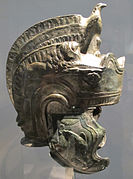Attic helmet

The Attic helmet was a type of helmet that originated in
The Attic helmet was similar to the
As an artistic motif, variations of the Attic helmet long outlasted other contemporary helmet types, being used to impart an archaic look to depictions of generals, emperors and Praetorians throughout the Hellenistic and Roman periods. As such, a form of Attic helmet has become part of the popular image of a Roman officer, as found in art from the Renaissance onwards or in earlier Hollywood productions. However, no archaeological remains of this type of helmet have been found to date. The closest surviving Imperial Roman helmet to the type illustrated in relief sculpture dates to the 2nd century AD, and was found in Bavaria. It has been classified as a "pseudo-Attic" helmet by some scholars. It is of tinned bronze and is very elaborately decorated with an integral crest raised from the skull incorporating an eagle.[3]
Gallery
-
Roman "pseudo-Attic" helmet, 2nd century AD.
-
The Praetorians Relief from the Arch of Claudius showing the type of Attic helmet, with an upstanding browband, commonly associated with Roman officers. This helmet type is only known from representations in art.
References
- ^ Connolly 1998, p. 60.
- ^ Connolly 1998, pp. 61–63, 107–109.
- ^ Connolly 1998, p. 237.
Bibliography
- Connolly, Peter (1998). Greece and Rome at War. London: Greenhill Books. ISBN 978-1-85367-303-0.
External links
 Media related to Attic helmets at Wikimedia Commons
Media related to Attic helmets at Wikimedia Commons


